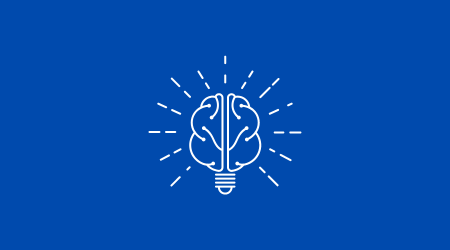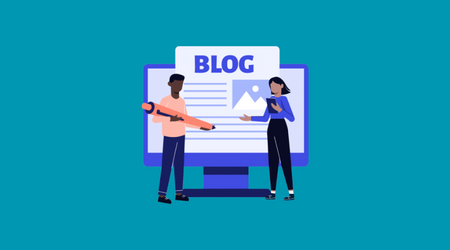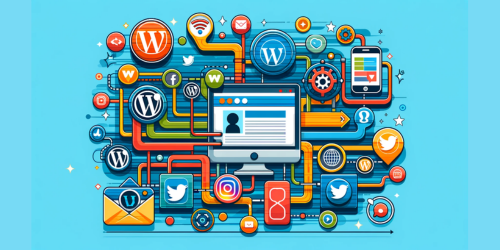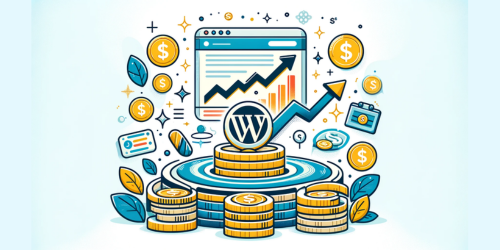In website development, WordPress reigns supreme. One of its crown jewels is its flexible and customizable layout system. But what exactly are WordPress layouts?
In essence, a WordPress layout is the structure or blueprint of your website—it’s how your website components are organized and displayed. From headers to footers, sidebars to content areas, the layout dictates where and how elements are positioned on a page.
The significance of WordPress layouts can’t be overstated. They directly impact the user experience, navigation, aesthetics, and ultimately, the success of your website. Whether you’re launching a personal blog or an eCommerce store, understanding WordPress layouts is integral to crafting an effective and engaging site, as we’ve discussed in our Step by Step Guide to Create a Website in 2020 – Super Easy.
1. The Anatomy of a WordPress Layout

The anatomy of a WordPress layout is like a puzzle, composed of several key pieces that, when put together, form a complete picture. Let’s break down these fundamental components:
I. Header
The header is the topmost part of a WordPress layout. It’s typically where you’ll find the site’s title or logo, primary navigation menu, and potentially additional elements like social media icons or a search bar.
Your header should be designed to capture the attention of your visitors and provide them with an intuitive means of navigating your site. Learn more on how to create a compelling logo in our guide for beginners.
II. Footer
The footer resides at the bottom of your website. It usually contains secondary information and links, such as terms of service, privacy policy, social media buttons, and contact details.
Some websites also incorporate newsletter subscription forms or widgets in the footer.
III. Sidebar
The sidebar is a vertical column often found on the right or left side of the main content area. It can host a wide range of elements including navigation links, social media feeds, text widgets, recent posts, ads, or a call to action.
IV. Content Area
This is the heart of your website where the primary content resides. The content area changes based on the page your visitor is on and can include blog posts, product descriptions, images, videos, contact forms, and more.
| Component | Description |
|---|---|
| Header | Topmost part with the site’s title or logo, primary navigation menu. |
| Footer | Bottom part with secondary information and links. |
| Sidebar | Vertical column with various elements like navigation links, widgets, ads. |
| Content Area | Central part with the main content, such as blog posts, images, videos, contact forms. |
Understanding these elements and how to effectively organize them is essential to creating a user-friendly WordPress layout.
2. Types of WordPress Layouts

There are numerous types of WordPress layouts available, each offering a unique structure and aesthetic to cater to different types of websites. Let’s delve into a few common ones:
I. Full-Width Layout
This layout spans the full width of the screen and does not have sidebars. It’s ideal for landing pages or any webpage where you want your content to take center stage without distractions.
Check out these Top Selling WordPress Themes which offer stunning full-width layouts.
II. Boxed Layout
Boxed layouts encapsulate the content area, and potentially the header and footer, within a box that’s visually distinct from the rest of the screen. This layout is often used for traditional or classic website designs.
III. Column Layouts
Column layouts divide the content area into multiple columns, typically two or three. This design is particularly useful for blogs, online magazines, or any site that aims to display multiple pieces of content simultaneously.
IV. Grid Layouts
Grid layouts split the content area into a series of grids. This layout style is often found on portfolio websites, photo blogs, or eCommerce websites that want to showcase multiple products or projects at once.
| Layout Type | Description |
|---|---|
| Full-Width Layout | No sidebars, ideal for landing pages or main content display. |
| Boxed Layout | Content, header, and footer are encapsulated within a distinct box. |
| Column Layouts | Divides the content area into multiple columns, ideal for blogs or online magazines. |
| Grid Layouts | Splits the content area into grids, suitable for portfolio or eCommerce websites. |
While these are some of the common types, there are numerous other layout options to explore and consider.
3. Choosing the Right Layout for Your Website
Choosing the right WordPress layout is like setting the stage for a performance. The layout sets the tone, impacts user experience, and plays a crucial role in achieving your website goals. Here are some factors to consider:
I. Purpose of Your Website
The first step is to understand the purpose of your website. If you’re creating a blog, a column layout might be best. If you’re showcasing artwork or photography, a grid layout may work well.
- User Experience: The user experience should always be front and center. For instance, if your site contains a lot of text, a full-width layout could enhance readability. Your choice of layout should make it easy for visitors to navigate your site and find the information they need.
- Aesthetic Appeal: Different layouts can evoke different feelings. A clean, minimal layout might convey professionalism, while a more complex grid layout could suggest creativity and dynamism. Choose a layout that aligns with your brand identity.
- Functionality: Ensure that your chosen layout supports all the features and functionality you need. For instance, if you plan on running ads on your site, you’ll need a layout with space for ad placement, perhaps in the sidebar or footer.
As you go through this process, remember that your layout isn’t set in stone. WordPress’s flexibility allows you to change and adjust your layout as your site evolves. You can always refer back to our step-by-step guide for more details.
4. Customizing WordPress Layouts
With WordPress, you’re not bound to a rigid framework. Its customization capabilities are vast, allowing you to design a site that’s uniquely yours. Let’s discuss how you can customize your WordPress layout:
I. Using the Built-in WordPress Customizer
WordPress has a built-in Customizer that lets you tweak various aspects of your layout. This tool allows you to adjust site identity, menus, widgets, homepage settings, and more. Plus, you can preview changes in real-time before making them live.
For a more in-depth look at how to utilize the WordPress Customizer, check out our article on how WordPress database works.
II. Using Page Builder Plugins
Page builder plugins are a game-changer for website customization. They offer a user-friendly, drag-and-drop interface that makes designing your layout a breeze, even if you’re not tech-savvy.
Our comparison of the 10 best drag-and-drop WordPress page builders can help you choose the right tool for your needs.
III. Using a Theme with Pre-designed Layouts
Many WordPress themes come with pre-designed layouts that you can import and customize. This can save you a significant amount of time, especially if you’re a beginner. Our list of top-selling WordPress themes showcases some fantastic themes with an array of layout options.
Whichever method you choose, remember to ensure your layout is responsive so that it looks great on all devices. After all, a significant portion of web traffic comes from mobile users.
5. Best Practices for WordPress Layouts
There’s an art to crafting an effective WordPress layout. Beyond simply choosing and customizing a layout, you need to consider several best practices:
- Responsive Design: With the rise of mobile browsing, it’s essential to ensure your layout is responsive. This means your website should automatically adjust to fit different screen sizes. Most modern WordPress themes and page builders offer responsive design capabilities.
- Readability and Typography: Choose fonts and colors that are easy to read and match your brand’s style. Break up walls of text with headings, bullet points, and images to improve readability. If you’re unsure about the cost implications of such customizations, our post on the cost to build a website can provide valuable insights.
- Using White Space Effectively: White space isn’t wasted space—it’s a powerful design tool. It helps separate elements, improves readability, and can make your site look more professional.
- Accessibility Considerations: Ensure your site is accessible to all users, including those with disabilities. This could involve making sure your site is navigable via keyboard or that images have alt text for screen readers.
By following these best practices, you can ensure your WordPress layout not only looks great but also provides a seamless user experience. For more SEO tips to boost your website’s performance, check out our guide on how to boost SEO on your website.
6. Common WordPress Layout Issues and How to Solve Them
Despite WordPress’s user-friendly interface, you might occasionally run into issues while working on your layouts. Don’t panic—most of these issues are common and can be solved with a little troubleshooting:
I. Sidebar Appearing Below the Content
If your sidebar is appearing below your content rather than next to it, it’s likely due to a width issue. Ensure that the combined width of your content area and sidebar doesn’t exceed the width of your overall site layout.
II. Changes Not Showing Up
If changes you’ve made to your layout aren’t reflecting on the site, you could be facing a cache issue. Try clearing your website’s cache via a caching plugin or your web host’s settings. Learn more about cache plugins in our best WordPress cache plugins post.
III. Layout Breaks on Mobile Devices
If your layout looks good on desktop but breaks on mobile, check if your theme or page builder supports responsive design. You might need to adjust settings specifically for mobile view.
IV. Layout Issues After Updating a Theme or Plugin
If your layout breaks after a theme or plugin update, try deactivating your plugins one by one to identify the culprit. If a theme update causes the issue, consider using a child theme to prevent losing customizations in the future.
7. FAQ
What is a responsive WordPress layout?
A responsive WordPress layout automatically adjusts to fit different screen sizes, ensuring your site looks great on all devices, including desktops, laptops, tablets, and smartphones.
Can I use different layouts on different pages of my WordPress site?
Absolutely! WordPress allows you to use different layouts for different pages, offering you the flexibility to cater to the unique needs of each page’s content.
Can I change my WordPress layout after I’ve set it up?
Yes, WordPress layouts are highly flexible. You can change your layout at any point using the WordPress Customizer, a page builder plugin, or by changing your theme. Read our guide on how to install, upload, and set up a new WordPress theme for more details.
How can I make my WordPress layout more SEO-friendly?
To make your layout more SEO-friendly, ensure it provides a good user experience, is easy to navigate, loads quickly, and is mobile-friendly. For a deeper dive into SEO, check out our guide on everything about keyword research for SEO.
8. Wrapping Up
Understanding WordPress layouts is vital to creating a successful website. Whether you’re a seasoned developer or a novice blogger, the layout you choose can significantly impact your site’s user experience, functionality, and aesthetic appeal. The right layout can set the stage for your content, highlight your brand, and help your website achieve its objectives.
Remember, there’s no one-size-fits-all approach to WordPress layouts. Different sites will require different layouts based on their purpose, target audience, and the kind of content they offer. But regardless of which layout you choose, ensure it aligns with your site’s goals, is easy to navigate, and provides an enjoyable user experience.
Keep in mind, WordPress is known for its flexibility and customizability, so don’t be afraid to experiment with different layouts and make changes as your website evolves. With a myriad of themes and page builders available, the sky’s the limit when it comes to designing your WordPress layout.
Remember to keep our comprehensive step-by-step guide handy, and here’s wishing you a successful website building journey!
Suggested Related Articles
- How Does a WordPress Database Work?
- 10 Best Drag and Drop WordPress Page Builders Compared
- Cost to Build a Website
- Boost SEO on Your Website
- Best WordPress Cache Plugins
- How to Install, Upload, and Set Up a New WordPress Theme
- Everything About Keyword Research for SEO
To stay updated with more such informative content, do follow us on our social media channels and subscribe to our newsletter. Happy website building!



